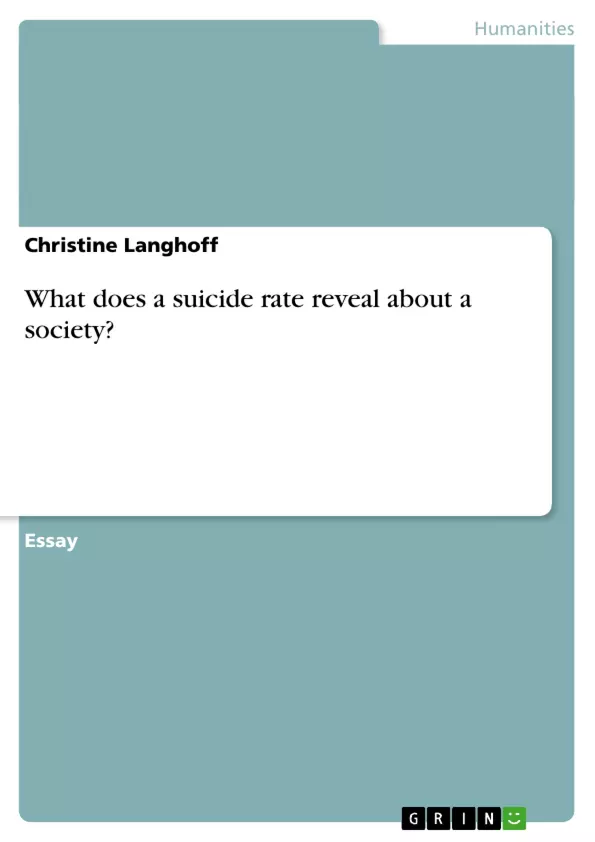Durkheim in his book “Suicide: A Study in Sociology” (1897) stated that “the term
suicide is applied to every case of death which results directly or indirectly from a
positive or negative act, carried out by the victim himself, knowing that it will produce
this result. An attempt is an act defined in the same way, but falling short of actual
death.” He used the study of suicide in order to illustrate his own methodological
approach and many studies that followed have been, at least in part, a reaction to his
work. Durkheim, although acknowledging that there are individual conditions which
can cause an individual to kill him/herself, emphasised that “every society is
predisposed to produce a certain number of voluntary deaths” and that “the
sociologist studies causes that affect not the individual but the group”. He believed
that the suicide rate “constitutes an order of facts which is unified and definite” and
that it can reveal certain aspects of society especially when looking at the different
types of suicide that have been committed. I am going to explore Durkheim’s theory
of suicide and what he believed a suicide rate reveals about a society. I am further
going to look at some other theories of suicide and how these have supported or
challenged Durkheim’s views. [...]
Inhaltsverzeichnis (Table of Contents)
- What does a suicide rate reveal about a society?
- The Study of Suicide
- Why did Durkheim choose to study suicide?
- Social Facts
- Durkheim’s approach to the study of suicide
- Durkheim’s Theory of Suicide
- Social Environments
- Types of Suicide
- Egoistic Suicide
- Anomic Suicide
- Altruistic Suicide
- Fatalistic Suicide
- Criticisms of Durkheim’s Theory
- Gibbs and Martin
- Douglas
- Baechler
- Atkinson
Zielsetzung und Themenschwerpunkte (Objectives and Key Themes)
This text explores Durkheim's theory of suicide and examines what he believed a suicide rate reveals about a society. It delves into Durkheim's methodological approach and analyzes how his work has been both supported and challenged by subsequent theories. The text also explores the criticisms raised against Durkheim's approach, highlighting alternative perspectives on the study of suicide.
- Durkheim's theory of suicide
- Social factors influencing suicide rates
- Different types of suicide
- Criticisms of Durkheim's approach
- Alternative theories of suicide
Zusammenfassung der Kapitel (Chapter Summaries)
- What does a suicide rate reveal about a society? This chapter introduces Durkheim's work on suicide and outlines his central argument that suicide rates reflect societal conditions rather than solely individual factors.
- The Study of Suicide This chapter examines Durkheim's reasons for choosing suicide as a subject of study, his emphasis on the concept of "social facts," and his approach to sociological analysis.
- Durkheim’s Theory of Suicide This chapter explores Durkheim's core theory of suicide, highlighting his analysis of social environments and the different types of suicide he identified: egoistic, altruistic, anomic, and fatalistic.
- Criticisms of Durkheim’s Theory This chapter examines various criticisms of Durkheim's approach to the study of suicide, including those by Gibbs and Martin, Douglas, Baechler, and Atkinson. These criticisms address the limitations of Durkheim's methodology, the significance of individual agency, and the interpretation of suicide statistics.
Schlüsselwörter (Keywords)
This text focuses on the study of suicide through a sociological lens, exploring themes of social integration, regulation, and the different types of suicide as defined by Durkheim. Key terms include social facts, egoistic suicide, altruistic suicide, anomic suicide, fatalistic suicide, status integration, and the interpretation of suicide statistics.
- Quote paper
- BA (Oxon), Dip Psych (Open) Christine Langhoff (Author), 2003, What does a suicide rate reveal about a society?, Munich, GRIN Verlag, https://www.grin.com/document/13243



